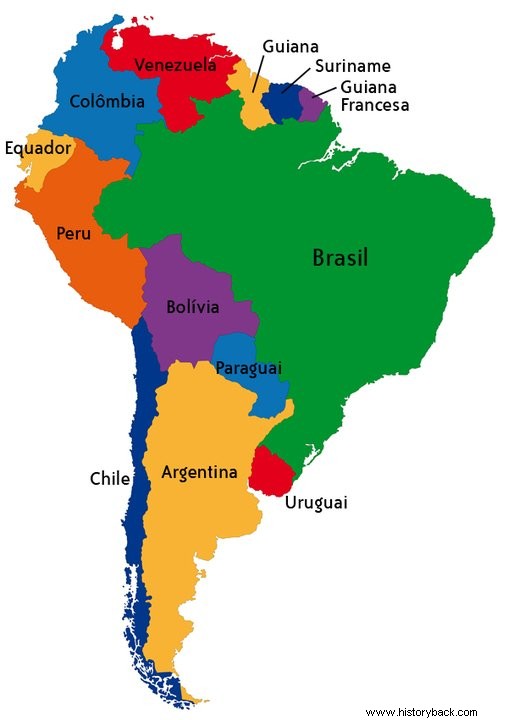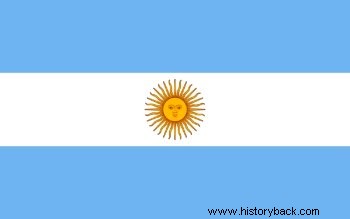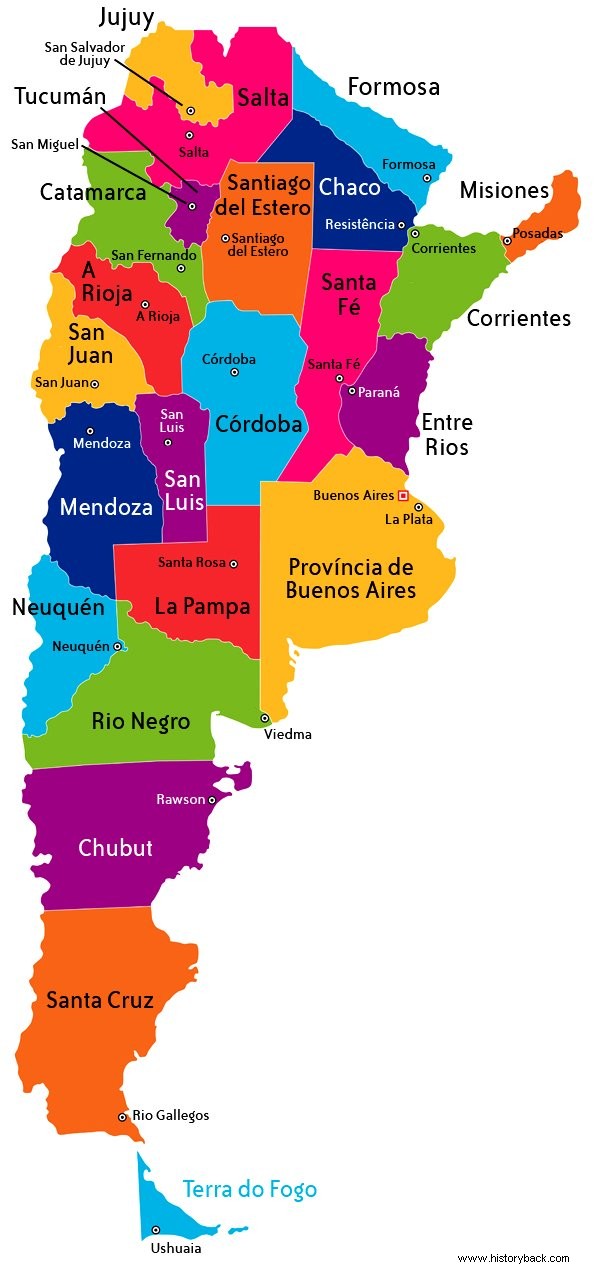Argentina , whose official name is the Argentine Republic, is a country located in southern South America , the largest after Brazil. It is among the ten largest countries in the world.
In terms of population, it is the third most populous country in South America, after Brazil and Colombia.
It is bathed by the Atlantic Ocean and borders Bolivia, Brazil, Chile, Paraguay and Uruguay. Paraná, Santa Catarina and Rio Grande do Sul are the Brazilian states that border the country.
Interestingly, the name Argentina comes from the Latin argentum , which means “silver”. That's because, according to legend, Argentina would be rich in this metal.
 Map of South America
Map of South America
General Data
- Capital: Buenos Aires
- Territorial Extent: 2,791,810 km²
- Inhabitants: Approximately 41 million (2015 data)
- Weather: Mainly tempered
- Language: Spanish
- Religion: Catholicism
- Currency: Argentine Peso
- Government System: Presidential Republic
Flag

The flag of Argentina, the country's official symbol, bears the colors blue and white in three horizontal stripes.
In the middle stripe (white) there is a sun in gold color with a human face inside. This representation of the sun is known as the “May sun”.
This is a reference to the revolution that took place between the 18th and 25th of May 1810 and aimed at independence from Spain.
Economy
Argentina's economy is the second strongest in South America. Thus, the country is one of the members of the Group of 20 (G20), a forum that brings together the 20 most economically influential countries.
Industry is the largest economic sector and tourism is undoubtedly one of the main activities in the country.
The country is a good exporter and has a highly developed agriculture due to the fertility of its soil. Most of the products exported by Argentines are agricultural.
Culture
Despite the fact that from the 1950s onwards immigration has decreased as a result of immigration rules that have been implemented, Argentina is a country of immigrants.
For this reason, its culture reveals characteristics, customs and lifestyles brought by European immigrants, especially Spanish and Italians.
The tango It is one of the main symbols of Argentina, and is considered a world heritage site. This sensual dance is an artistic manifestation that is a true mark of Argentines, being another way to attract people from all over the world to the country.
In addition to tango, they are also world heritage sites:
- Grave of the Hands , a cave famous for having several hands painted by indigenous people inside.
- Ischigualasto and Talampaya , nature reserves that are archaeological sites.
- Apple and Jesuit Estancias , imposing constructions made for the Jesuits where there are the university, the church and houses of residence. These are the main tourist attractions in Córdoba, the second largest city in Argentina in terms of population.
- Jesuit Guarani Missions , preserved ruins of constructions made at the time of the Jesuit missions in places inhabited by Guarani.
- Iguaçu National Park , two-thirds of this park belongs to Argentina.
- Los Glaciares National Park It is one of the largest parks in the country. This natural landscape of mountains and ice was declared a UNESCO heritage site in 1981.
- Peninsula Valdes , located in Patagonia, is teeming with whales, seals and other marine animals and migrating birds.
- Qhapaq Nan , which means “main road”, is a route that is over 30,000 kilometers long and over 2,000 years old.
- Quebrada de Humahuaca , an isolated valley whose habitation dates back more than 10 thousand years.
- Filtered Porteño , a style of decorative art, a typical Buenos Aires painting that uses spirals and bold colors.
Despite excelling in other sports, soccer it is an attraction that moves the tourist activity in Argentina. It is the most popular sport and for which Argentines are passionate about.
With regard to gastronomy , Argentina is especially known for its barbecue. There is a lot of beef consumption. In addition, chorizos and empanadas are famous.
Various types of pasta and pizza are also part of its menu, which is influenced by Italian immigrants.
Argentina is a great wine producer, which has very good drinkers. Mate infusion is another drink that cannot be missed in the country.
See also:Tango:origin, characteristics and artistsProvinces
The country is divided into 7 regions:Centro, Cuyo, Mesopotamia, Northwest Argentina, Pampas, Patagonia and Norte.
Argentina has 23 provinces and one Federal District, the Ciudad Autónoma de Buenos Aires:
- Province of Buenos Aires
- Catamarca, Chaco, Chubut, Cordoba, Corrientes
- Between Rivers
- Formosa
- Jujuy
- La Pampa, La Rioja
- Mendoza, Misiones
- Neuquén
- Black River
- Salta, San Juan, San Luis, Santa Cruz, Santa Fe, Santiago del Estero
- Terra del Fuego, Tucumán
 The 23 provinces of Argentina and their respective capitals
The 23 provinces of Argentina and their respective capitals
Sights
Bariloche It is a popular destination for Brazilians looking for snow. In addition to a very beautiful natural landscape, which invites you to practice sports and walks, the city has a very interesting offer for gastronomy and nightlife.
Another popular city is Rosário , known as the birthplace of the Argentine flag. The Flag Monument is located there, as it was in the Flag National Park that the country's flag was raised for the first time.
Ushuaia It is also a popular tourist destination. It is in the southernmost city in the world, known as “the city at the end of the world”, that the Museum of the End of the World was built in 1903.
In this museum, visitors can find information about local history and indigenous culture. In addition, there are data on shipwrecks that happened in the vicinity of the city.
The Iguazu Falls form a large set of 275 waterfalls, known at least by name by Brazilians. It is a spectacle of nature that is a world heritage site. The Iguazu Falls are located in Argentina and also in Brazil, in the state of Paraná.
Continue your search :
- South American countries
- Independence of Spanish America
- Platinum America
- Latin America
- OAS - Organization of American States
- Spanish Colonization
- Avoid Peron
